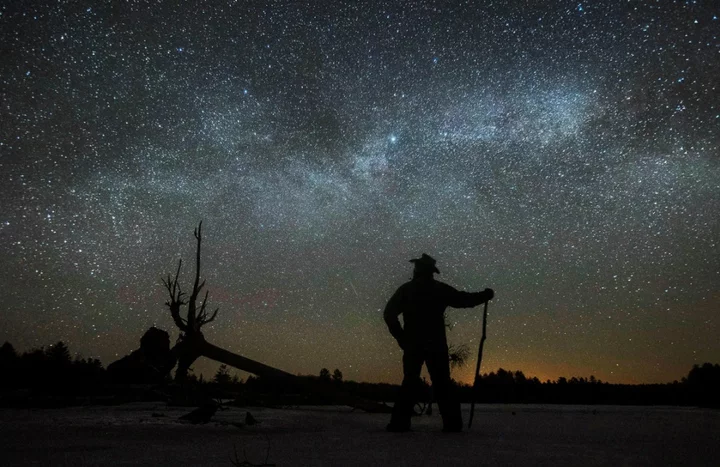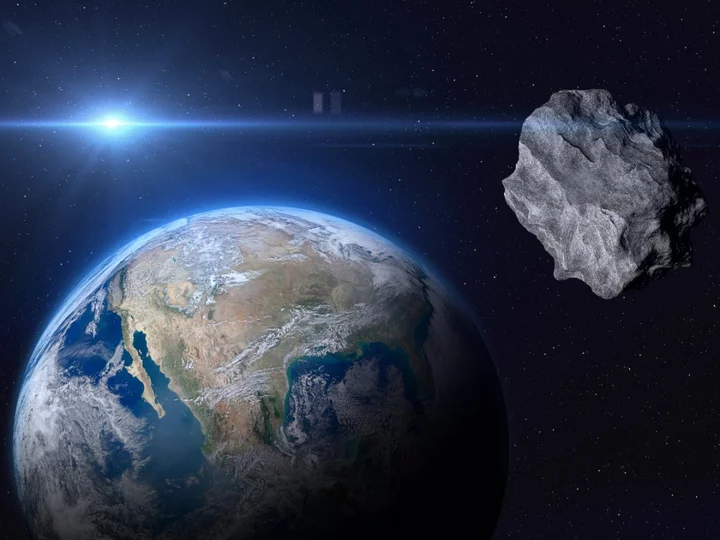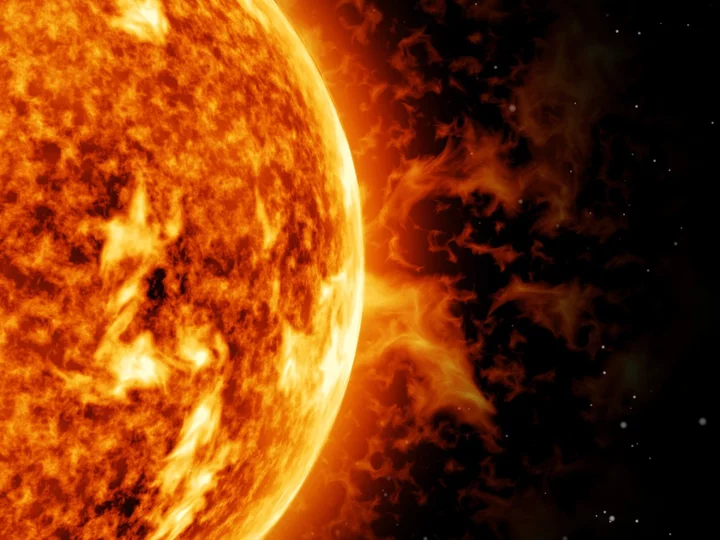
Amazon builds $120 million satellite processing hub in Florida
By Joey Roulette WASHINGTON Amazon is building a $120 million processing facility at NASA's Kennedy Space Center in
2023-07-21 21:20

A mysterious source has been sending radio signals to Earth from space for decades
An unknown source has been sending radio blasts towards Earth since at least 1988, scientists say. The researchers do not know what object is sending the radio waves towards Earth. The nature of the waves is such that they do not conform with any models that attempt to explain it. For 35 years, the source has been sending out regular 20-minute blasts of energy that vary considerably in their brightness, researchers say. The emissions appear something like the blasts that come out of pulsars or fast radio bursts, which last for milliseconds to several seconds. But the newly discovered source sends radio signals that pulsate on a period of 21 minutes – something previously thought impossible by expected explanations. Pulsars are neutron stars that spin around quickly, throwing out radio blasts as they do. When one crosses Earth, the emissions can be picked up very briefly and brightly, like being in the path of the light from a rotating lighthouse. Scientists believe that process can only work if the magnetic field of the pulsar is strong, and it is rotating quickly enough – if not, there would not be enough energy to see the pulsar from Earth. That has led to the development of the “pulsar death line”, which suggests that sources must be spinning fast and strong enough to be detected. The newly discovered object named GPMJ1839-10, however, is way beyond that death line. If it is a pulsar, then it seems to be operating in ways that scientists thought impossible. It could also be a highly magnetised white dwarf or magnetar, an extra kind of neutron star with incredibly strong magnetic fields. But they do not tend to send out emissions of this kind, researchers believe. The signals have been detected on Earth since at least 1988, scientists found by going through old records, but they had gone unnoticed by those collecting that data. After the source was detected, researchers checked radio archives and found that the source has been repeating for at least 35 years. Yet more discoveries may be made in this way in the future, said Victoria M Kaspi, a professor of physics at McGill University who did not work on the study. “Only time will tell what else lurks in these data, and what observations across many astronomical timescales will reveal,” she wrote in an accompanying article. That might include some explanation of how unusual the newly discovered source is. By examining whether there are is a similar collection of other objects in the data, researchers might be able to understand the mechanisms behind the newly discovered emissions. The findings are reported in a new paper, ‘A long-period radio transient active for three decades’, published in the journal Nature. Read More Scientists invent self-healing solar panels with ‘miracle material’ Powerful solar flare to disrupt communications, Russians warn New technique represents major breakthrough in search for aliens, scientists say
2023-07-19 23:52

Webb telescope captures tantalizing evidence for mysterious 'dark stars'
By Will Dunham WASHINGTON Scientists for the past 15 years have been looking for evidence of a type
2023-07-18 01:49

Large asteroid flies close to Earth – and is only spotted days later
Earth narrowly avoided an asteroid that flew past last week – and scientists did not spot the object until it had made its visit. The object, named 2023 NT1, was spotted on 15 July by the Atlas observatory in South Africa. Astronomers there say it was up to 60 metres in size. But at that point it had already made the dangerous bit of its journey: two days earlier, it had swept past Earth, at just a quarter of a distance between us and the Moon. At 60,000 miles away, that is a long way from doing any damage, but relatively close for an asteroid. As such, the asteroid didn’t pose any danger to Earth. But it was an important reminder that truly dangerous asteroids could fly towards Earth – and that we might not spot them until they are too late. That is because many asteroids, including 2023 NT1, fly towards us from the Sun. The bright light of our star can make it difficult to see anything else, especially asteroids that are relatively small at the scale of space. The European Space Agency estimates there could be a million asteroids in the same size range of 30 to 100 metres near Earth. And 98.9 per cent of them are still undiscovered, the space agency says. It has said that shows that there needs to be an improvement in the capabilities of humanity to detect such asteroids. Some are already being worked on, such as ESA’s NEOMIR, which will orbit between the Sun and the Earth and is designed to work as an early warning system for asteroids that would otherwise avoid detection, but will not launch until 2030. The asteroid 2023 NT1, at 60 metres across, is among the largest to have come so close to Earth in recent times. At that size, it could have done significant damage: the Chelyabinsk meteoroid that injured 1,500 people and damaged buildings when it fell to Earth in 2013 was only 20 metres across, for instance. From its approach last week, scientists have been able to catalogue and predict the asteroid’s movements. That should make it possible to track and spot it next time it comes close to Earth. Read More Powerful solar flare to disrupt communications, Russians warn What to expect from India’s Chandrayaan-3 mission to Moon’s south pole India launches historic mission to Moon’s south pole
2023-07-17 23:51

Powerful solar flare to disrupt communications, Russians warn
Russian scientists have warned that powerful solar flare activity on Monday may cause significant disruption for satellite and radio communications. Three solar flares observed on Sunday by the Fedorov Institute of Applied Geophysics in Moscow lasted up to 14 minutes, signalling abnormally large geomagnetic disturbances on Earth. The institute forecasted the arrival of class X flares for Monday, which are the most energetic type of solar radiation, capable of damaging electronics. Earlier this month, a giant sunspot named AR3354 grew to a size roughly 10 times larger than Earth, unleashing an X-class flare aimed directly at Earth that triggered radio blackouts in some parts of the US. The latest solar activity is expected to interfere with short-wave radio communications, used by military, maritime and emergency operators. Increased solar storm activity in recent years has led to fears of an impending solar superstorm, which some astronomers warn could lead to an “internet apocalypse”. Such powerful storms occur approximately once every 100 years, with the last major one taking place in 1921. Nasa predicts that the next peak in the Sun’s 11-year activity cycle will arrive at some point in 2025, though it is not clear yet whether this will be the once-in-a-century event that some astronomers fear. The worst on record, referred to as the Carrington Event, took place in 1859 and resulted in fires at telegraph stations. “If the Carrington Event happened today, it would have even more severe impacts, such as widespread electrical disruptions, persistent blackouts, and interruptions to global communications,” the US space agency warned in a recent blog post. “Such technological chaos could cripple economies and endanger the safety and livelihoods of people worldwide.” Research published in 2021 assessed the robustness of internet and communications infrastructure against severe space weather events The study found that coronal mass ejection events could risk disconnecting Europe from the US, with the authors urging more to be done to improve the resilience of global telecommunication networks. In March this year, Nasa announced a new artificial intelligence model capable of predicting where on Earth a solar storm may strike, giving scientists up to 30 minutes of advanced warning. Vishal Upendran, from the Inter-University Center for Astronomy and Astrophysics in India, who was involved in the AI’s development, said: “With this AI, it is now possible to make rapid and accurate global predictions and inform decisions in the event of a solar storm, thereby minimising – or even preventing – devastation to modern society.” Read More Once-in-a-century solar superstorm could plunge the world into ‘internet apocalypse’, study says Powerful solar flare responsible for blackout in US What to expect from India’s Chandrayaan-3 mission to Moon’s south pole India launches historic mission to Moon’s south pole
2023-07-17 19:57

India blasts Chandrayaan-3 lander toward moon's south pole
(Refiles to fix paragraph 7 to say Chandrayaan-2 mission was launched in 2019, not 2020) By Nivedita Bhattacharjee BENGALURU (Reuters)
2023-07-14 22:19

‘Ghost stars’ have aligned themselves in a strange pattern in our galaxy – and scientists might now know why
“Ghost” stars are aligned in beautiful structures near the centre of our galaxy, scientists say – and they might finally be getting to know why. Researchers discovered the unusual alignment of these planetary nebulae ten years ago, when Manchester doctoral student Bryan Rees spotted them. But it has remained a mystery how they came to be that way. Now scientists have been able to confirm that unusual alignment. But they have also made a breakthrough in finding out why they are there, after they found that a particular group of stars known as binary stars is responsible. Planetary nebulae are gas clouds that are thrown out from stars when they come to the end of their life. Our own star, the Sun, will do the same in about five billion years. Those ejected clouds are like ghosts of their dying stars, and assemble themselves in beautiful shapes, researchers say, such as an hourglass or butterfly. Researchers studied a range of planetary nebulae that are near the centre of our Milky Way. Though they are not related and come from different stars and different times, many of their shapes are similar, lining up in the same way and on the same plane. In the new study, scientists found that the alignment happens when those ghosts have a close companion star. The companion orbits around the main star, at the centre of the planetary nebulae, at a very close orbit. Without such a companion star, the nebulae do not line up in the mysterious pattern. That suggests that the alignment is linked to the splitting of the binary components when the star is born. “This finding pushes us closer to understanding the cause for this mysterious alignment,” said Albert Zijlstra, co-author and professor in astrophysics at The University of Manchester. “Planetary nebulae offer us a window into the heart of our galaxy and this insight deepens our understanding of the dynamics and evolution of the Milky Way’s bulge region. “The formation of stars in the bulge of our galaxy is a complex process that involves various factors such as gravity, turbulence, and magnetic fields. Until now, we have had a lack of evidence for which of these mechanisms could be causing this process to happen and generating this alignment. “The significance in this research lies in the fact that we now know that the alignment is observed in this very specific subset of planetary nebulae.” Researchers looked at 136 confirmed planetary nebulae in the galactic bulge, or the thickest section of our Milky Way. They used the European Southern Observatory’s Very Large Telescope, and then looked at 40 more of them using images from the Hubble Space Telescope. The findings are reported in a new paper, ‘When the Stars Align: A 5 σ Concordance of Planetary Nebulae Major Axes in the Centre of our Galaxy’, in the Astrophysical Journal Letters. Read More Euclid: UK-backed mission ready to uncover mysteries of the dark universe Jeff Bezos’ rocket exploded and he didn’t tell anyone Nasa unveils ‘astrovans’ to carry Artemis moon mission astronauts Jeff Bezos’ rocket exploded and he didn’t tell anyone Nasa unveils ‘astrovans’ to carry Artemis moon mission astronauts Nasa releases James Webb telescope image on one-year anniversary
2023-07-14 01:47

Deep space orbit to provide non-traditional resting place
Gerry and Elizabeth Paulus love taking road trips across the United States, and soon they’ll be preparing for
2023-07-12 18:16

Alien planet with metallic clouds resembles 'a giant mirror in space'
By Will Dunham WASHINGTON It is a planet astronomers say probably should not even exist. Researchers said on
2023-07-11 01:22

The Universe has sped up to an extreme level, scientists confirm
The universe went in “extreme slow motion” at its beginning, and has dramatically sped up since, scientists have found. The discovery, predicted by Einstein’s general theory of relativity, was finally confirmed after scientists observed the universe soon after the Big Bang. Einstein’s theory suggests that we should be able to see the distant universe, when it was much older than it is today, running much more slowly. But scientists have not been able to actually look that far and confirm the theory. Now scientists have used bright quasars as a sort of space clock, allowing them to measure time when the universe was much older than it is today. “Looking back to a time when the universe was just over a billion years old, we see time appearing to flow five times slower,” said Geraint Lewis from the University of Sydney, lead author on the new research. “If you were there, in this infant universe, one second would seem like one second – but from our position, more than 12 billion years into the future, that early time appears to drag.” Professor Lewis and other researchers gathered data from 200 quasars for the research. Quasars are very active supermassive black holes that sit in the middle of early galaxies, and hence provide a reliable way to look back at a much younger universe. Previous researchers have done the same using supernovae, or massive exploding stars. Those are useful but they are also difficult to see at the very very long distances of the early universe, meaning that the confirmation was limited only to about half the age of the cosmos. Now by using quasars scientists were able to look much further back, to just a tenth of the age of the universe, when it was only a billion years old. “Thanks to Einstein, we know that time and space are intertwined and, since the dawn of time in the singularity of the Big Bang, the universe has been expanding,” Professor Lewis said. “This expansion of space means that our observations of the early universe should appear to be much slower than time flows today. “In this paper, we have established that back to about a billion years after the Big Bang.” The work is described in a new paper, ‘Detection of the cosmological time dilation of high-redshift quasars’, published in Nature Astronomy. Read More Astronomers discover ‘shooting stars’ on the Sun Tonight’s ’supermoon’ will be biggest full moon of 2023 so far – here’s how to see it Euclid: UK-backed space mission takes off to uncover mysteries of dark universe Astronomers discover ‘shooting stars’ on the Sun Tonight’s ’supermoon’ will be biggest full moon of 2023 so far – here’s how to see it Euclid: UK-backed space mission takes off to uncover mysteries of dark universe
2023-07-03 23:30

Europe's Euclid space telescope set for launch to explore 'dark universe'
By Steve Gorman A SpaceX rocket in Florida stood poised for launch on Saturday carrying an orbital telescope
2023-07-01 14:51

Virgin Galactic rocket plane poised for first commercial flight to edge of space
By Jose Luis Gonzalez and Steve Gorman TRUTH OR CONSEQUENCES, New Mexico A twin-fuselage jet stood ready on
2023-06-29 16:26
